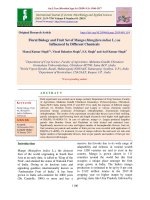Productivity dynamics of groundnut as influenced by different plant densities and fertilizer levels during summer season
Bạn đang xem bản rút gọn của tài liệu. Xem và tải ngay bản đầy đủ của tài liệu tại đây (221.32 KB, 6 trang )
Int.J.Curr.Microbiol.App.Sci (2020) 9(3): 2571-2576
International Journal of Current Microbiology and Applied Sciences
ISSN: 2319-7706 Volume 9 Number 3 (2020)
Journal homepage:
Original Research Article
/>
Productivity Dynamics of Groundnut as Influenced by Different Plant
Densities and Fertilizer Levels During Summer Season
Shailesh S. Khillare*, P. V. Mahatale, S. D. Hiwale, N. K. Darekar,
S. T. Dangore and W. V. More
Oilseed Research Unit, Dr. Panjabrao Deshmukh Krishi Vidyapeeth, Akola (M.S.), India
*Corresponding author
ABSTRACT
Keywords
Ground nut, plant
density, fertilizer
level, summer
Article Info
Accepted:
20 February 2020
Available Online:
10 March 2020
An experiment entitled Productivity dyanamics of groundnut as influenced by
different plant densities and fertilizer levels during summer season was carried out
during summer season of 2015 at the farm of Oilseed Research Unit, Dr.
Panjabrao Deshmukh Krishi Vidyapeeth, Akola (M.S.). The treatments comprised
of three spacing 30 x 10 cm, 25 x 10 cm and 20 x 10 cm and three fertilizer levels
75%, 100% and 125% RDF ha-1. The experiment was laid out in a factorial
randomized block design (FRBD) with three replications. Among three spacing,
30 x 10 cm was superior over 20 x 10 cm in respect of plant height (cm), number
of branches plant-1, plant spread (cm), number of root nodules plant-1,dry matter
accumulation plant-1 (g), haulm yield (kg ha-1). Treatment 20 x 10 cm was superior
over 30 x 10 cm in respect to pod yield (3038 Kg ha-1), biological yield (6993 kg
ha-1) and Harvest index (42.50%). The growth and yield attributes showed
significantly increased when use of 125 % RDF ha-1. Pod yield (2809 Kg ha-1),
haulm yield (4248 Kg ha-1) obtained was significantly higher at application of 125
% RDF ha-1 than 75 % and 100 % RDF ha-1. Use of 125% RDF ha-1 was found to
most economical than 75 % and 100 % RDF.
Introduction
Groundnut (Arachis hypogea L.) or peanut
commonly called as poor man`s nut is an
important oilseed cum legume crop of India.
Groundnut belongs to C3 plant, it needs good
sunshine and high temperature to produce
more pods. India ranks second in production
of groundnut after China. At the global level,
50 per cent of the groundnut produced is used
for oil extraction, 37 per cent for
confectionary and 12 per cent for seed
purpose.
Where as in India, 80 per cent of the
groundnut produced is used for oil extraction,
11 per cent as seed, 8 per cent used as direct
food and only 1 per cent of groundnut is
exported. The by-product of this crop like
haulm is rich in protein content (10-12 %) and
2571
Int.J.Curr.Microbiol.App.Sci (2020) 9(3): 2571-2576
used as nutritious feed for cattle. As
groundnut belongs to fabaceae family which
maintains the soil fertility by fixing the
atmospheric nitrogen which fulfils its
requirement. According to the national
economic survey, Indian adult could consume
7.2 kg year-1 capita-1 i.e. 20 g oil per day
against 55 g day-1 capita-1 in western
countries.
The growth rate of oilseed crops in terms of
production was much higher after 1980’s as
compared to other crops with the introduction
of technology mission on oilseeds (TMO) in
1986 and it brought “Yellow Revolution’’ in
oilseed crops in India. Groundnut is a cash
crop and it is useful for crop rotation. It is
easy to grow, withstand drought to some
extent and hence a choice crop for dry
farming.
It is a soil erosion resisting crop. Being
leguminous crop it can fix atmospheric
nitrogen with the help of symbiotic
relationship of bacteria in root nodules and
there by reduces fertilizer requirement of
succeeding crop. Thus maintain soil fertility.
All parts of the plant can be commercially
used. Commercially and nutritionally it is a
very important source of oil. Groundnut
contains 13 different vitamins (including A,
the B group C and E) along with 26 essential
trace minerals, including calcium and iron.
Materials and Methods
The field experiment was conducted during
summer season of 2015 at the Oilseed
Research Unit, Dr. Panjabrao Deshmukh
Krishi Vidhyapeeth, Akola during summer
2014-15. The topography of the experimental
field was uniform leveled and well drained.
The meteorological data indicated that the
maximum temperature ranged between
23.7°C to 42.9°C and was observed at 1th and
19th meteorological week.
Whereas, minimum temperature ranged from
11.0°C to 27.8°C and it was registered at 1th
and 21thmeteorological week respectively.
The total rainfall of 80.02 mm was received in
6 rainy days during the experimentation. The
minimum and maximum sunshine hours was
ranged from 8.2 to 9.8 hours.
The maximum and minimum wind velocity
also ranged from 4.2 to 90 km hr1 during the
period of experiment. The assured irrigation
facilities were therefore needed for growing
crops during summer.
The soil of
experimental site was clay loam in texture,
low in available nitrogen (146 kg ha-1),
medium in available phosphorus (16 kg ha-1)
and fairly rich in available potassium (290 kg
ha-1).
The soil was moderately alkaline in reaction
(pH 8.1) with EC (0.45 dSm-1). It was
moderately high in organic carbon. The
experiment was laid out in Factorial
Randomized Block design with three
replications. Nine treatment combinations
were formed with a view to integration of
three planting densities and three fertilizer
levels.
TAG-24 variety was used for sowing. The
groundnut kernels were treated with
biofertilizers like Rhizobium and PSB culture
@ 250 g per 10 kg seeds. Single seed was
dibble hill-1 by maintaining spacing according
to treatments viz., 30 cm x 10 cm (PP @ 3.33
lakh ha-1), 25 x 10 cm (PP @ 4.00 lakh ha-1)
and 20 x 10 cm (PP @ 5.00 lakh ha-1) and
three fertilizer levels 75%, 100% and 125%
RDF ha-1. The lines were marked with the
help of marker and sowing of the crop was
done on 21th January, 2015.
The recommended dose of fertilizer i.e. 25 kg
N through urea and 50 Kg P2O5 ha-1 through
single super phosphate and 30 kg K through
muriate of potash was applied as a basal dose.
2572
Int.J.Curr.Microbiol.App.Sci (2020) 9(3): 2571-2576
The correct quantity to be applied in each
treatment was calculated on the basis of
nutrient content of fertilizer used.
Results and Discussion
Plant population
The initial and final (at harvest) plant stand
ha-1 as influenced by various treatments are
compiled in Table 1.
Effect of planting densities
The plant population under study exhibited
significant difference amongst themselves at
initial stage and at harvest. However, these
differences due to different plant spacing.
Effect of fertilizer levels
The plant population under study neither
exhibited significant difference at initial stage
nor at harvest due to different fertilizer levels.
Growth attributes
The data pertaining to mean growth attributes
of groundnut as influenced by different
treatments at harvest during summer 2015 are
presented in Table 2.
The increase in growth attributes in S1
spacing (30 x10 cm) might be due to less
plants competition for nutrients, water and
space. Denser plant population has less
availability of macro and micro nutrients and
hence less plant height as compare to low
plant population. Above results are in
agreement with findings of Migawer et al.,
(2000) and Kausale et al., (2002)
Effect of fertilizer levels
The growth attributes viz., plant height (cm),
plant spread (cm), number of branches plant-1,
number of nodules plant-1 and dry matter
plant-1 (g) were not found significant at
harvest stages. However numerically high
value of growth attributes viz., plant height
(15.06 cm), plant spread (31.08 cm), number
of branches plant-1(5.87), number of nodules
plant-1 (26.56) and dry matter plant-1 (24.12 g)
was recorded with treatment F3 (125% RDF)
and treatment F1 (75 % RDF) recorded
minimum growth attributes viz., plant height
(14.68 cm), plant spread (29.85 cm), number
of branches plant-1(5.42), number of nodules
plant-1 (25.78) and dry matter plant-1 (23.63
g). Similar results were reported by Sable
(2002), Thakre et al., (2003) and Throve and
Dhonde (2007).
Effect of planting densities
Effect of plant densities
The growth attributes viz., plant height (cm),
plant spread (cm), number of branches plant-1,
number of nodules plant-1 and dry matter
plant-1 (g) were found to be significant
difference due to plant densities at harvest. In
S1 spacing (30 x 10 cm) verified maximum
growth attributes viz., plant height (15.81
cm), plant spread (32.04 cm), number of
branches plant-1 (6.15), number of nodules
plant-1 (25.78) and dry matter plant-1 (24.25 g)
which was significantly superior over spacing
S2 (25 x 10 cm) and spacing S3 (20 x 10 cm).
The yield of groundnut viz., pod yield (kg ha1
), haulm yield (kg ha-1), biological yield (kg
ha-1) and harvest index due to different
planting densities was found to be significant
at harvest. The crop grown with spacing S3
(20 x 10 cm) shows more yield of groundnut
viz., pod yield (3038 kg ha-1), biological yield
(6993 kg ha-1) and harvest index (42.58
%)than other treatments of spacing viz., S2
(25 x 10 cm) and the crop grown with spacing
S1 (30 x 10 cm). This might be happened due
to the effect of planting densities, high plant
densities has more number of plant as
2573
Int.J.Curr.Microbiol.App.Sci (2020) 9(3): 2571-2576
compare to low plant densities and hence per
plant yield may be less but due to the effect of
high plant density per hectare yield was
recorded more. The haulm yield kg ha-1 due
to different planting densities was found to be
significant at harvest. The crop grown with
treatment S1 (30 x 10 cm) recorded
significantly highest haulm yield (4391 kg ha1
) than spacing S2 and spacing S3 which was
at par with each other. This might be
happened due to the effect of planting
densities, high plant densities has more
competition for nutrients and hence less dry
matter accumulation per plant takes place per
hectare as compare to low plant densities.
Above results obtained are in agreement with
the findings of Rama Jyoti et al., (2004) and
Ghosh et al., (2005).
F2 (100 % RDF). Treatment F1 (75 % RDF)
recorded minimum yield of groundnut viz.,
pod yield (2376 kg ha-1), haulm yield (4059
kg ha-1) and biological yield (6435 kg ha-1).
Effect of fertilizer levels
This might be happened due to the effect of
different doses of fertilizer, high fertilizer
levels has more availability of nutrients as
compare to low fertilizer levels and hence
results in maximum dry matter production per
plant and ultimately more
dry matter
production per hectare results in more
biological yield and harvest index in high
fertilizer levels. Above results obtained are in
agreement with the findings of Nwokwu
(2006).
The yield of groundnut viz., pod yield (kg ha1
), haulm yield (kg ha-1) and biological yield
(kg ha-1) due to the different fertilizer levels
was found significant at harvest. The
treatment F3 (125 % RDF) recorded more
yield of groundnut viz., pod yield (2809 kg
ha-1), haulm yield (4248 kg ha-1) and
biological yield (7001 kg ha-1) and found
significantly superior over F1 (75 % RDF) and
This might be due to less availability of
nutrients in treatment F1 as compare to
treatment F3 and hence shows less pod yield
kg ha-1. Above results obtained are in
agreement with the findings of Rajnikanth et
al., (2008), Elayraja and Singarvel (2009) and
Karunakaran et al., (2010). The harvest index
due to different fertilizer levels was found to
be non-significant. However, the crop grown
with treatment F3 (125 % RDF) shows more
value of harvest index (39.22 %). Treatment
F1 (75 % RDF) shows less value of harvest
index (36.86 %).
Table.1 Emergence and final plant stand ha-1 as influenced by different treatments
Treatments
Planting densities
S1 – 30 x 10 cm (3.33 lakh ha-1)
S2 – 25 x 10 cm (4 lakh ha-1)
S3 – 20 x10 cm (5 lakh ha-1)
S.E. (m) ±
C D at 5 %
Fertilizer levels
F1 – 75 % of RDF
F2 – 100 % of RDF
F3 – 125 % of RDF
S.E. (m) ±
C D at 5 %
2574
Plant count (ha-1)
Initial
Final
327513
378968
478703
4606
13810
321825
373015
472222
4995
14977
388227
400132
396825
4606
NS
381481
393518
392063
4995
NS
Int.J.Curr.Microbiol.App.Sci (2020) 9(3): 2571-2576
Table.2 Mean growth attributes of groundnut as influenced by different treatments at harvest
Treatments
Planting densities
S1 – 30 x 10 cm (3.33 lakh ha -1)
S2 – 25 x 10 cm (4 lakh ha-1)
S3 – 20 x10 cm (5 lakh ha-1)
S.E. (m) ±
C D at 5 %
Fertilizer levels
F1 – 75 % of RDF
F2 – 100 % of RDF
F3 – 125 % of RDF
S.E. (m) ±
C D at 5 %
Growth attributes
No. of
No of
branches
nodules
Plant-1
Plant-1
Plant
height
(cm)
Plant
spread
(cm)
Dry matter
Plant-1
(gm)
15.81
14.94
14.02
0.15
0.44
32.04
29.38
28.31
0.29
0.86
6.15
5.90
4.87
0.19
0.56
25.78
25.67
25.00
0.49
NS
24.25
24.19
23.02
0.19
0.56
14.68
15.03
15.06
0.15
NS
29.85
30.80
31.08
0.29
NS
5.42
5.63
5.87
0.19
NS
25.78
24.11
26.56
0.49
NS
23.63
23.71
24. 12
0.19
NS
Table.3 Mean yield of groundnut as influenced by different treatments at harvest
Treatments
Planting densities
S1 – 30 x 10 cm (3.33 lakh ha-1)
S2 – 25 x 10 cm (4 lakh ha-1)
S3 – 20 x10 cm (5 lakh ha-1)
S.E. (m) ±
C D at 5 %
Fertilizer levels
F1 – 75 % of RDF
F2 – 100 % of RDF
F3 – 125 % of RDF
S.E. (m) ±
C D at 5 %
Pod yield
(kg ha-1)
Haulm yield
(kg ha-1)
Biological
yield (kg ha-)
Harvest
index
2275
2479
3038
83.69
250.90
4391
4135
4009
48.11
144.23
6667
6615
6993
111.92
335.76
34.09
37.40
42.58
0.83
2.48
2376
2608
2809
83
250.90
4059
4229
4248
48
144.23
6435
6838
7001
111.92
335.55
36.86
37.99
39.22
0.83
NS
The growth and yield attributes found
maximum when crop grown with spacing S1
30 cm x 10 cm (Plant Population @ 3.33 lakh
ha-1) over other plant spacing. The growth and
yield attributes recorded maximum with
treatment F3 (125 % RDF).
Acknowledgment
The authors duly acknowledge the Head and
Advisory
committee
Department
of
Agronomy for research work and technical
support related to the research.
References
Elayaraja, D. and R. Singaravel 2009. Effect
of organic wastes and NPK levels on
nutrient uptake and yield of groundnut
in coastal sandy soil Madras Agric. J.
96 (7-12): 362-364.
Ghosh, P.K., and Dayal Devi. 2005.
Optimization of date of sowing in a new
groundnut-wheat relay cropping in
2575
Int.J.Curr.Microbiol.App.Sci (2020) 9(3): 2571-2576
semi-arid
tropics
of
India.
J.Sustainable Agric. 26(3): 83-94.
Karunakaran, V. J., Rammohan, V.
Chellamuthu and R. Poonghuzhalan
2010. Effect of integrated nutrient
management on the growth and yield of
groundnut in costal region of Karaikal.
Indian J. Agron. 55(2)128-132
Kausale, S.P., S.B. Shinde, L.K. Patel and
N.S. Borse 2002. Effect of integrated
nutrient management on nodulation, dry
matter accumulation and yield of
summer groundnut at south Gujarat
condition. Legume Res. 32(3):227-229.
Migawer, A., Ekram, A.M. Mona and
Soliman (2000) Performance of two
peanut cultivars and their response to
NPK fertilization in newly reclaimed
loamy sand soil. J. Agric. Sci. Mansoura
Univ. 26 (11): 6653 – 6667.
Nwokwu, G.N. International research journal
2006. Influence of phosphorus and plant
spacing on the growth and yield of
Groundnut Department of Crop
Production
and
Landscape
Management, Faculty of Agriculture
and Natural Resources Management,
Ebonyi State University, Abakaliki,
Nigeria.
Rajanikanth, E., M.V.R. Subrahmanyam and
J.V. Rao 2008. Effect of integrated
nutrient management practices on
growth and yield of rainfed groundnut,
Arachis hypogaea L. intercropped with
guava, Psidium guajava. J. Oilseeds
Res. 25 (2): 157-160.
Rama Jyothi, M., C Radha Kumari, U.
Obulamma and B.
Lingam 2004.
Responce of early rabi groundnut to
spacing, irrigation and plant protection
levels. 21(1):171-172.
Sable, R.N.,2002. Studies on nitrogen source
on growth and yield of kharif
groundnut. J. Maharashtra agric. Univ.
27(3); 322-324.
Thakare, G.V., R.B.
Ulemale, R.S.
Shivankar, and A.A. Dahiphale 2003.
Morphological indices and yield
attributes as influenced by integrated
nutrient
management
summer
groundnut. Ann. Pl. Physiol. 17(1):1-5.
Thorave, D.S. and M.B. Dhonde 2007.
Morphological indices and yield
attributes as influenced by integrated
nutrient
management
summer
groundnut. Ann. Pl. Physiol.21(1):186188.
How to cite this article:
Shailesh S. Khillare, P. V. Mahatale, S. D. Hiwale, N. K. Darekar, S. T. Dangore and More. W.
V. 2020. Productivity Dynamics of Groundnut as Influenced by Different Plant Densities and
Fertilizer Levels During Summer Season. Int.J.Curr.Microbiol.App.Sci. 9(03): 2571-2576.
doi: />
2576

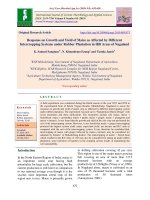
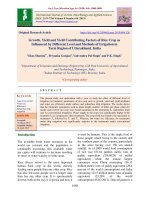

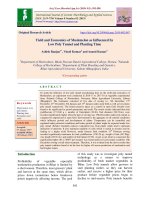
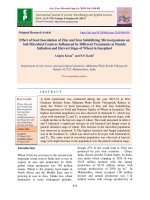
![Growth and yield of Ashwagandha [Withania somnifera (L.)] as influenced by different intercropping system in Kymore plateau of Madhya Pradesh](https://media.store123doc.com/images/document/2020_01/09/medium_vsb1578562778.jpg)


